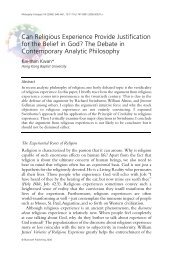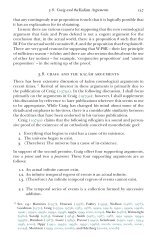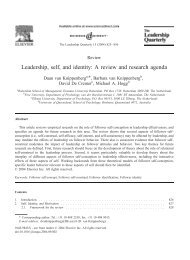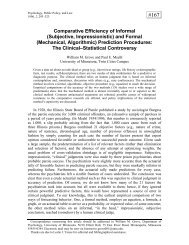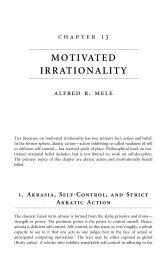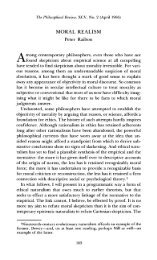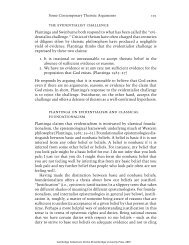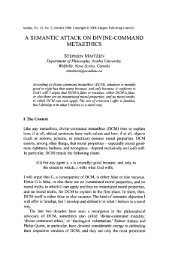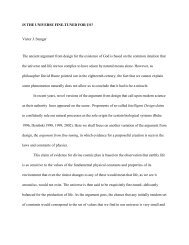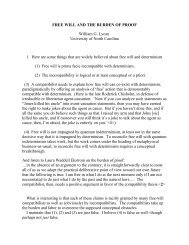Atheism and Theism JJ Haldane - Common Sense Atheism
Atheism and Theism JJ Haldane - Common Sense Atheism
Atheism and Theism JJ Haldane - Common Sense Atheism
You also want an ePaper? Increase the reach of your titles
YUMPU automatically turns print PDFs into web optimized ePapers that Google loves.
Reply to <strong>Haldane</strong> 157<br />
the football. Contexts such as ‘Joe believes that . . .’ <strong>and</strong> ‘Joe desires that . . .’<br />
are examples of intensional contexts. We can get round the difficulty roughly<br />
by saying with Quine ‘Joe believes-true S’ where S might be the sentence ‘The<br />
head of the philosophy department is the dean of the faculty of arts’. 11 This<br />
sentence is certainly different from the tautologous sentence ‘The head of the<br />
philosophy department is the head of the philosophy department’. And we<br />
could say ‘Joe wants-true of himself “possesses a unicorn”’. 12 ‘Wants-true of<br />
himself’ signifies a relation between Joe <strong>and</strong> a predicate. Sentences <strong>and</strong> predicates<br />
certainly exist. We can of course say this whether or not Joe knows<br />
English, <strong>and</strong> we can talk in this way even of the beliefs <strong>and</strong> desires of cats.<br />
The sentence just serves vaguely to single out a belief or desire, a mental<br />
state, <strong>and</strong> in my opinion a brain state. (If someone prefers to think of beliefs<br />
<strong>and</strong> desires as functional states which are multiply realized by brain states,<br />
I can agree without compromising my materialism. Incidentally ‘functional’<br />
here is more like ‘function’ in mathematics: it is not a teleological notion.)<br />
The development of this sort of approach in a sophisticated way would go<br />
beyond the confines of the present book, but the general approach suggests<br />
how it can remove some mystery from both intensionality (with an ‘s’) <strong>and</strong><br />
consequently ‘intentionality’ (with a ‘t’). 13<br />
Thus when I use the word ‘unicorn’ I do not refer to a unicorn because<br />
there are no unicorns to be referred to. ‘Cat’ refers to the set of cats, past,<br />
present <strong>and</strong> future. It does not refer to counterfactual cats because there<br />
are no such. I here differ from David Lewis 14 who has a realistic theory<br />
of possible worlds other than the actual world. I deal with counterfactuals<br />
in a different way, following Quine. 15 ‘If it had been the case that p then<br />
it would have been the case that q’ said by me to you is true relative to<br />
me, you <strong>and</strong> the context if <strong>and</strong> only if q follows by first order logic from p<br />
together with contextually agreed background assumptions. Because counterfactuals<br />
have this contextual <strong>and</strong> relativist character they are to be avoided,<br />
where possible, in science <strong>and</strong> metaphysics. Thus I disagree with <strong>Haldane</strong><br />
when he speaks of future <strong>and</strong> counterfactual cats (see p. 106). I believe in<br />
future cats (there they are up ahead of us in space–time) but not in counterfactual<br />
cats.<br />
3 Consciousness<br />
Consciousness may be thought to provide a particular difficulty for a physicalist<br />
philosophy of mind. I concede that there seems to be something mysterious<br />
about the fact of consciousness, as if some strange supernatural light was lit<br />
up in our minds. I hold that all the properties of immediate experience are<br />
‘topic neutral’ ones, neutral between materialism <strong>and</strong> mind–body dualism.



